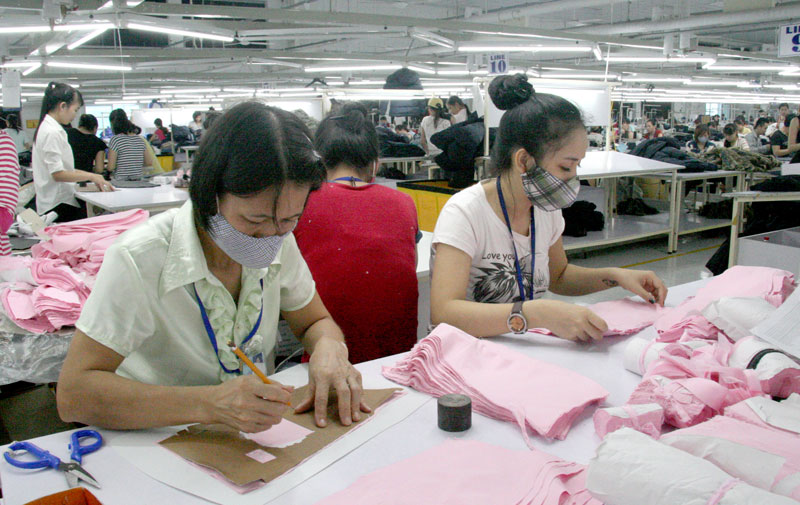
(HBO) – Da Hop joint Stock Company has agreed to provide 1.5 hectares of land for Diostech Co., Ltd from the Republic of Korea to build a factory on manufacturing electronic components for digital cameras and cell phones at Da River Left-Bank Industrial Zone in Hoa Binh city.
A land leasing agreement was signed by the two companies’ representatives in July.
Workers of GGS Co., Ltd, in Da River Left-Bank Industrial Zone, work at a garment product for export production chain.
The facility has an investment of 20 million USD, expected to create jobs for hundreds of local residents and giving a bright outlook for the province’s industrial development.
According to Diostech, the firm has operated a factory in Vinh Phuc and selected Da River Left-Bank Industrial Zone to locate the new facility as it has developed infrastructure, reasonable lease rates together with competitive source of skilled workers in comparison with other cities and provinces.
The industrial park is home to many foreign enterprises, including Japan’s producer of lenticular lens Sanko and GGS from the Republic of Korea.
Meanwhile, Luong Son Industrial Park has more than 10,000 workers with an occupancy rate reaching 90 percent.
Luong Son district now has three industrial zones, including 83-ha Luong Son, 200-ha Nam Luong Son and 213-ha Nhuan Trach industrial parks.
The Nam Luong Son IP has cement plants Trung Son and Vinh Son and a vocational training school with an occupancy rate of 48 percent.
The district has lured 17 foreign direct investment projects so far with a total investment of more than 280,500 USD, accounting for 53 percent of the province’s FDI. Some 478 domestic companies have been established in the province, registering a total capital of 9.18 trillion VND, making up 20 percent of the province’s firms.
Industrial Production Index of Hoa Binh increased 9.69 percent year on year in the first half of 2017, said Director of the provincial Department of Industry and Trade Vu Mai Ho. Industrial production earned the province nearly 13.47 trillion VND, up 15.91 percent from the same period last year and fulfilling 50.16 percent of the yearly target. Processing industry has seen the biggest growth during the period due to stable prices of input materials.
Several industrial producers, for example, of sugar and starch, have recovered their operations after a period of suspension.
Hoa Binh has zoned off eight areas for industrial parks, covering a total area of 1,672 hectares. By 2020, the province plans to have 21 industrial clusters with a total area of 663 hectares./.
According to data from the Hoa Binh Provincial Party Committee, the industrial production index for the first six months of 2025 is estimated to have increased by 20% compared to the same period last year. This marks the highest year-on-year growth rate for this period since 2020.
In the first six months of 2025, Hoa Binh province’s export turnover was estimated at 1.145 billion USD, marking an 18.11% increase compared to the same period in 2024. Import turnover was estimated at $ 804 million, a 17.15% increase, which helped the province maintain a positive trade balance.
The lives of the ethnic minority farmers in Tan Lac district have gradually improved thanks to the new directions in agricultural production. This is a testament to the collective strength fostered through the professional associations and groups implemented by various levels of the district’s Farmers’ Union.
With the motto the "product quality comes first,” after nearly one year of establishment and operation, Muong village’s Clean Food Agricultural and Commercial Cooperative, located in Cau Hamlet, Hung Son Commune (Kim Boi district), has launched reputable, high-quality agricultural products to the market that are well-received by consumers. The products such as Muong village’s pork sausage, salt-cured chicken, and salt-cured pork hocks have gradually carved out a place in the market and they are on the path to obtaining the OCOP certification.
In the past, the phrase "bumper harvest, rock-bottom prices" was a familiar refrain for Vietnamese farmers engaged in fragmented, small-scale agriculture. But today, a new spirit is emerging across rural areas of Hoa Binh province - one of collaboration, organisation, and collective economic models that provide a stable foundation for production.
Maintaining growing area codes and packing facility codes in accordance with regulations is a mandatory requirement for agricultural products to be eligible for export. Recently, the Department of Agriculture and Environment of Hoa Binh province has intensified technical supervision of designated farming areas and packing facilities to safeguard the "green passport" that enables its products to access international markets.



